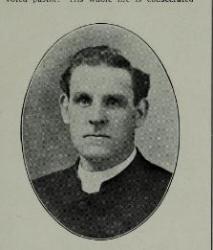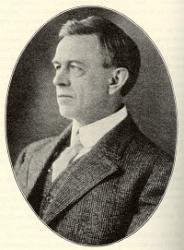Planning worship?
Check out our sister site, ZeteoSearch.org,
for 20+ additional resources related to your search.
- |
User Links
Person Results
Alfred Barratt

1879 - 1968 Author of "Mother's Old Bible Is True" in The Cyber Hymnal Barratt, Alfred. (New Springs, Wigan, Lancashire, England, October 25, 1879--December, 1968). Coming to the United States as a young man, he studied at Gordon College, Massachusetts, and Newton Theological Seminary, Mass. He was ordained in December, 1913, by the Baptists in Connecticut, then by the Wheeling WV Presbytery, Presbyterian Church in the USA, in 1924. He was pastor of Dallas, West Virginia, then of a series of churches in the Presbytery of Clarion, Pennsylvania. In 1937 he was awarded the Doctor of Literature degree by Bob Jones College.
On November 26, 1962, he wrote the undersigned: "For 39 long years I have labored hard and steady writing sermons, children's story sermons, and hymns. Up to the present day I have written 4,477 hymns. 80 percent of my sermons are published in books and magazines."
--William J. Reynolds, DNAH Archives
Alfred Barratt
R. H. Cornelius

1872 - 1933 Person Name: Rufus Henry Cornelius Composer of "[My mother’s old Bible is pointing the way]" in The Cyber Hymnal R.H. Cornelius, known as Rufus Cornelius by his friends, was born in Blount Co., AL., January 24, 1872. He was educated in the public schools of Oneonta, the county seat. He began teaching in the public schools at an early age and at one time was associate Principle of the Oneonta High School. It was while teaching in the high school that he became interested in church music and began to study with some of the best teachers of the time. His first major teacher was the late A J showalter in one of his normals at Eden, AL. He continued his study with this wellknown teacher until he had finished the courses a second time. He soon felt that the study of harmony was his first love in his study and soon became one of the best harmon teachers of his time.
Near the close of the century, he moved to Texas and settled in Midlothian, Ellis Co., where he established a publishing house and published many fine gospel song books that sold by the thousands. However, before coming to Texas, he was associated with The Showalter-Patton Co. who published his first compositions. Soon after coming to Texas, he devoted much time to teaching singing schools (Cornelius Normal Musical Institute) and soon became one of the best known teachers of that great state, often having many more calls for schools than he could have time for. In many cases his schools were dated years ahead. he had possessed a beautiful tenor voice and was of a very pleasant personality. This caused his to be loved by all who knew him. About 1914 he was called to Southwestern Baptist Seminary as head of the music department. After several years here in the Baptist School in Ft Worth, Texas, he felt he was more needed back in the field of teaching and songbook publishing. Soon after coming to Texas, he married Maycon Temperance Burleson, who was a fine singer and musician and wrote many songs.During the first 32 years of the 20th Century, this couple of musicians blessed the State of Texas with their singing and teaching. Of all the fine song written by Mr. Cornelius, "Oh, I want to See Him" will carry his memory for years to come. The Cornelius' were members of the Baptist Church and were devoted Christians.
Mr. Cornelius passed away in 1932. Mrs. Cornelius lived only about two years, passing away in 1934. In the passing of these fine gospel singer and teachers, church music suffered a great loss. By C C Stafford
--www.findagrave.com/cgi-bin/ (excerpts)
R. H. Cornelius
Harry Dixon Loes

1895 - 1965 Composer of "[For mother's love and father's care]" in Youth Worship and Sing Pseudonyms:
Deal
Bartells
Born Harold Loes, the American gospel song writer took the middle name Dixon in honour of A. C. Dixon, the pastor of Moody Church at the time. Harry Dixon Loes studied at Moody Bible Institute, and after extensive training in music he served a number of churches with a ministry of music. From 1939 until his retirement he was a member of the music faculty of Moody Bible Institute. He wrote the lyrics for 1,500 gospel songs, and composed 3,000 tunes.
One day in 1915, Paul Rader preached a sermon in Moody Church, in Chicago. His theme was, “All that I want is in Jesus.” In the congregation was young Harry Dixon Loes, then a senior at Moody Bible Institute, where he would eventually teach. Inspired by Dr. Rader’s message, Harry Loes wrote the words and music for a song he called "All Things in Jesus." It was first sung by the church’s youth group.
Friends all around me are trying to find
What the heart yearns for, by sin undermined;
I have the secret, I know where ’tis found:
Only true pleasures in Jesus abound.
All that I want is in Jesus.
He satisfies, joy He supplies;
Life would be worthless without Him;
All things in Jesus I find.
Some carry burdens whose weight has for years
Crushed them with sorrow and blinded with tears.
Yet One stands ready to help them just now,
If they will humbly in penitence bow.
--http://wordwisehymns.com/2010/02/09/
==================
Harry Dixon Loes was born in Kalamazoo, Michigan, on October 20, 1892. After serving several churches as music director and later being active for more than twelve years in evangelist work, he joined the music faculty of Moody Bible Institute, in 1939, where he remained as a popular music teacher until his death in 1965. Mr. Loes was the writer of numerous gospel songs and choruses.
One day, while listening to a sermon on the subject of Christ's atonement entitled “Blessed Redeemer,” Mr. Loes was inspired to compose this tune. He then sent the melody with the suggested title to Mrs. Christiansen, a friend for many years, asking her to write the text. The hymn first appeared in Songs of Redemption, compiled by Marin and Jelks, in 1920, and published by the Baptist Home Mission Board, Atlanta, Georgia.
--http://www.gracecommunitycog.org/
Harry Dixon Loes
Theodore Baker
1851 - 1934 Translator of "Lo, How a Rose E’er Blooming" in Voices Together Theodore Baker (b. New York, NY, 1851; d. Dresden, Germany, 1934). Baker is well known as the compiler of Baker's Biographical Dictionary of Musicians (first ed. 1900), the first major music reference work that included American composers. Baker studied music in Leipzig, Germany, and wrote a dissertation on the music of the Seneca people of New York State–one of the first studies of the music of American Indians. From 1892 until his retirement in 1926, Baker was a literary editor and translator for G. Schirmer, Inc., in New York City. In 1926, he returned to Germany.
Psalter Hymnal Handbook, 1987
Theodore Baker
William Farley Smith
1941 - 1997 Person Name: William Farley Smith, 1941-1997 Arranger of "PENITENT" in Community of Christ Sings
William Farley Smith
G. B. Timms
1910 - 1997 Person Name: G. B. Timms, 1910-1997 Author of "Sing we of the blessèd Mother" in The New English Hymnal Full name George Boorne Timms
G. B. Timms
M. B. Williams
Author of "My Mother's Bible" in The Voice of Praise Milan Bertrand Williams; evangelist; fl. 1896-1910
LOC Name Authority Files
M. B. Williams
Charles M. Fillmore

1860 - 1952 Person Name: C. M. F. Author of "Tell Mother I'll Be There" in Timeless Truths Charles Millard Fillmore, 1860-1952
Born: July 15, 1860, Paris, Illinois.
Died: September 17, 1952, Indianapolis, Indiana.
Fillmore won a music scholarship at the Cincinnati College of Music, then taught for a year at Bath Seminary in Owingsville, Kentucky. He then traveled for about a year and taught singing classes in various parts of America. He then went for additional music studies in Cincinnati, Ohio. He studied for the ministry at Butler University in Indianapolis, Indiana, graduating in 1890. He pastored in Lafayette, Indiana; Shelbyville, Indiana; was "State Evangelist" (for one year) in Ogden, Utah; Peru, Indiana; Carthage, Ohio; and Hillside Church, Indianapolis, Indiana. He was one of the editors of the temperance paper Clean Politics, and of The Musical Messenger. He wrote several hundred Gospel songs in his lifetime.
--www.hymntime.com/tch
Charles M. Fillmore
Norman Warren
1934 - 2019 Composer of "MOTHER TERESA" in Hymns for Today's Church (2nd ed.)
Norman Warren
S. L. Findlater
1823 - 1907 Translator of "O happy home, where Thou art loved the dearest" in The Church Hymnal Sarah Laurie Borthwick Findlater United Kingdom 1823-1907. Born in Edinburgh, Scotland, sister of Jane Laurie Borthwick, she married Erick John Findlater, a pastor in the Free Church of Scotland at Lochearnhead, Perthshire, and they had three daughters: Sarah Jemima, Mary Williamina, and Jane Helen. Findlater and her sister Jane's translations were collected in “German hymns from the land of Luther”, appearing in four volumes (1854-1862). As an author, Sarah wrote fiction, juvenile works, music scores, anthems, and musical parts. She died at Torquay, Devon, England.
John Perry
S. L. Findlater


 My Starred Hymns
My Starred Hymns


